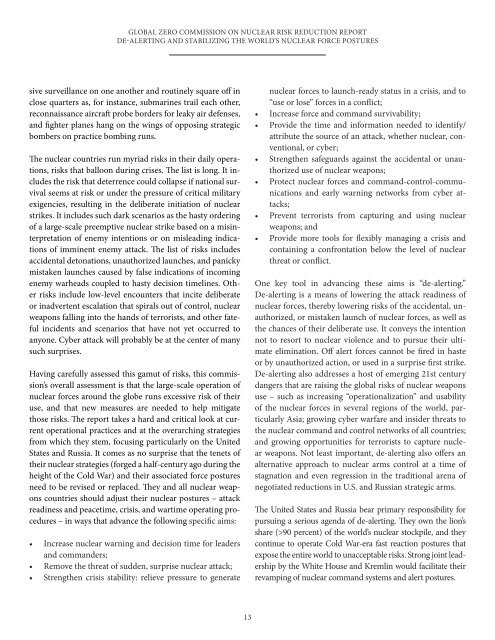global_zero_commission_on_nuclear_risk_reduction_report
global_zero_commission_on_nuclear_risk_reduction_report
global_zero_commission_on_nuclear_risk_reduction_report
Create successful ePaper yourself
Turn your PDF publications into a flip-book with our unique Google optimized e-Paper software.
GLOBAL ZERO COMMISSION ON NUCLEAR RISK REDUCTION REPORTDE-ALERTING AND STABILIZING THE WORLD’S NUCLEAR FORCE POSTURESsive surveillance <strong>on</strong> <strong>on</strong>e another and routinely square off inclose quarters as, for instance, submarines trail each other,rec<strong>on</strong>naissance aircraft probe borders for leaky air defenses,and fighter planes hang <strong>on</strong> the wings of opposing strategicbombers <strong>on</strong> practice bombing runs.The <strong>nuclear</strong> countries run myriad <strong>risk</strong>s in their daily operati<strong>on</strong>s,<strong>risk</strong>s that ballo<strong>on</strong> during crises. The list is l<strong>on</strong>g. It includesthe <strong>risk</strong> that deterrence could collapse if nati<strong>on</strong>al survivalseems at <strong>risk</strong> or under the pressure of critical militaryexigencies, resulting in the deliberate initiati<strong>on</strong> of <strong>nuclear</strong>strikes. It includes such dark scenarios as the hasty orderingof a large-scale preemptive <strong>nuclear</strong> strike based <strong>on</strong> a misinterpretati<strong>on</strong>of enemy intenti<strong>on</strong>s or <strong>on</strong> misleading indicati<strong>on</strong>sof imminent enemy attack. The list of <strong>risk</strong>s includesaccidental det<strong>on</strong>ati<strong>on</strong>s, unauthorized launches, and panickymistaken launches caused by false indicati<strong>on</strong>s of incomingenemy warheads coupled to hasty decisi<strong>on</strong> timelines. Other<strong>risk</strong>s include low-level encounters that incite deliberateor inadvertent escalati<strong>on</strong> that spirals out of c<strong>on</strong>trol, <strong>nuclear</strong>weap<strong>on</strong>s falling into the hands of terrorists, and other fatefulincidents and scenarios that have not yet occurred toany<strong>on</strong>e. Cyber attack will probably be at the center of manysuch surprises.Having carefully assessed this gamut of <strong>risk</strong>s, this <str<strong>on</strong>g>commissi<strong>on</strong></str<strong>on</strong>g>’soverall assessment is that the large-scale operati<strong>on</strong> of<strong>nuclear</strong> forces around the globe runs excessive <strong>risk</strong> of theiruse, and that new measures are needed to help mitigatethose <strong>risk</strong>s. The <strong>report</strong> takes a hard and critical look at currentoperati<strong>on</strong>al practices and at the overarching strategiesfrom which they stem, focusing particularly <strong>on</strong> the UnitedStates and Russia. It comes as no surprise that the tenets oftheir <strong>nuclear</strong> strategies (forged a half-century ago during theheight of the Cold War) and their associated force posturesneed to be revised or replaced. They and all <strong>nuclear</strong> weap<strong>on</strong>scountries should adjust their <strong>nuclear</strong> postures – attackreadiness and peacetime, crisis, and wartime operating procedures– in ways that advance the following specific aims:• Increase <strong>nuclear</strong> warning and decisi<strong>on</strong> time for leadersand commanders;• Remove the threat of sudden, surprise <strong>nuclear</strong> attack;• Strengthen crisis stability: relieve pressure to generate<strong>nuclear</strong> forces to launch-ready status in a crisis, and to“use or lose” forces in a c<strong>on</strong>flict;• Increase force and command survivability;• Provide the time and informati<strong>on</strong> needed to identify/attribute the source of an attack, whether <strong>nuclear</strong>, c<strong>on</strong>venti<strong>on</strong>al,or cyber;• Strengthen safeguards against the accidental or unauthorizeduse of <strong>nuclear</strong> weap<strong>on</strong>s;• Protect <strong>nuclear</strong> forces and command-c<strong>on</strong>trol-communicati<strong>on</strong>sand early warning networks from cyber attacks;• Prevent terrorists from capturing and using <strong>nuclear</strong>weap<strong>on</strong>s; and• Provide more tools for flexibly managing a crisis andc<strong>on</strong>taining a c<strong>on</strong>fr<strong>on</strong>tati<strong>on</strong> below the level of <strong>nuclear</strong>threat or c<strong>on</strong>flict.One key tool in advancing these aims is “de-alerting.”De-alerting is a means of lowering the attack readiness of<strong>nuclear</strong> forces, thereby lowering <strong>risk</strong>s of the accidental, unauthorized,or mistaken launch of <strong>nuclear</strong> forces, as well asthe chances of their deliberate use. It c<strong>on</strong>veys the intenti<strong>on</strong>not to resort to <strong>nuclear</strong> violence and to pursue their ultimateeliminati<strong>on</strong>. Off alert forces cannot be fired in hasteor by unauthorized acti<strong>on</strong>, or used in a surprise first strike.De-alerting also addresses a host of emerging 21st centurydangers that are raising the <str<strong>on</strong>g>global</str<strong>on</strong>g> <strong>risk</strong>s of <strong>nuclear</strong> weap<strong>on</strong>suse – such as increasing “operati<strong>on</strong>alizati<strong>on</strong>” and usabilityof the <strong>nuclear</strong> forces in several regi<strong>on</strong>s of the world, particularlyAsia; growing cyber warfare and insider threats tothe <strong>nuclear</strong> command and c<strong>on</strong>trol networks of all countries;and growing opportunities for terrorists to capture <strong>nuclear</strong>weap<strong>on</strong>s. Not least important, de-alerting also offers analternative approach to <strong>nuclear</strong> arms c<strong>on</strong>trol at a time ofstagnati<strong>on</strong> and even regressi<strong>on</strong> in the traditi<strong>on</strong>al arena ofnegotiated reducti<strong>on</strong>s in U.S. and Russian strategic arms.The United States and Russia bear primary resp<strong>on</strong>sibility forpursuing a serious agenda of de-alerting. They own the li<strong>on</strong>’sshare (>90 percent) of the world’s <strong>nuclear</strong> stockpile, and theyc<strong>on</strong>tinue to operate Cold War-era fast reacti<strong>on</strong> postures thatexpose the entire world to unacceptable <strong>risk</strong>s. Str<strong>on</strong>g joint leadershipby the White House and Kremlin would facilitate theirrevamping of <strong>nuclear</strong> command systems and alert postures.13


